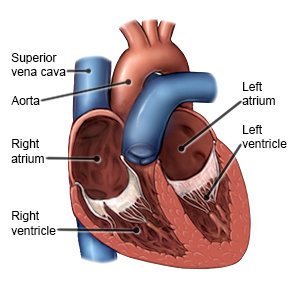Living with your Heart Failure Monitoring System
Medically reviewed by Drugs.com. Last updated on Jun 5, 2024.
AMBULATORY CARE:
What you need to know about your heart failure (HF) monitoring system:
Your HF monitoring system measures pressure near your heart. It does this through a sensor that is placed in your pulmonary artery. Your pulmonary artery brings blood from your heart to your lungs. The sensor is placed during a heart catheterization. Ask your healthcare provider for more information about this procedure.
 |
How a HF monitoring system works:
Pressure readings are sent to your healthcare provider through the internet. This information can help your healthcare provider identify and treat HF problems early. Early identification and treatment can prevent your HF from getting worse. It can also prevent or decrease hospital stays.
Equipment that is part of the monitoring system:
The patient electronic system (PES) is a small box with a screen. The screen gives you directions for how to take pressure readings. It also records and sends pressure readings to your healthcare provider. The PES is connected to the following:
- A recording pillow helps your PES read information from your sensor.
- A remote helps you take a pressure reading while you lie on the recording pillow.
- An antenna or phone cord lets you send a pressure reading to your healthcare provider. This is done through wireless internet or through your phone line.
Call your doctor or cardiologist if:
- You have questions or concerns about your condition or care.
How to take a pressure reading:
Ask your healthcare provider how often to take a pressure reading. Do not take a reading near a waterbed, electric blanket, or metal detector. Place your PES on a firm, flat surface. Place your recording pillow 5 feet or less from your PES. Make sure you can see the PES screen from where you will take your reading. Check that the PES is connected to the recording pillow.
- Remove your belt and jewelry before you take a reading. Also remove keys or other metal objects from your pockets. These items can prevent a correct reading.
- Turn on the PES. Make sure that it is connected to an antenna or phone line.
- Lie on the recording pillow. Make sure you have the remote and that it is plugged into the PES.
- Press the button on the remote when you see "Start" on the PES screen. Slowly adjust your position on the pillow until the bar on the PES screen turns green. The PES may give you instructions to help you get into the correct position. For example, the PES may tell you to "Shift slightly on pillow." The PES will tell you "Good position on pillow" when you are in the right position.
- Lie still on the recording pillow. The PES will play music until the pressure reading is complete. This usually takes about 20 seconds. The PES will tell you when the reading is complete.
- Wait for the PES to tell you that the reading has been sent. This make take several minutes. The PES will tell you "Reading sent successfully." The PES will turn off after this message.
Clean the PES directed:
Unplug the power cord before you clean the PES. Remove the case from the recording pillow and wash it with other clothes. Wipe the pillow, PES, and cords with a cloth and mild detergent. Do not spray detergent onto the PES or cords. This could damage them.
Carry your medical identification card with you at all times:
You will be given a temporary card before you leave the hospital. Your permanent card will be mailed to you. The information on the card can help healthcare providers keep you safe in an emergency. It can also help them keep you safe during an x-ray, CT, or MRI.
Bring your equipment with you when you travel:
Remove the antenna and cords from the PES before you pack it. You can pack the equipment in its case, or you can use your own case. Carry on the equipment with you when you travel by airplane.
Follow up with your doctor or cardiologist as directed:
Write down your questions so you remember to ask them during your visits.
© Copyright Merative 2024 Information is for End User's use only and may not be sold, redistributed or otherwise used for commercial purposes.
The above information is an educational aid only. It is not intended as medical advice for individual conditions or treatments. Talk to your doctor, nurse or pharmacist before following any medical regimen to see if it is safe and effective for you.
Further information
Always consult your healthcare provider to ensure the information displayed on this page applies to your personal circumstances.
